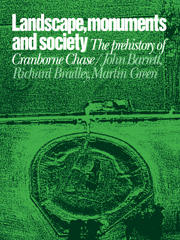5 - The Middle Bronze Age
Published online by Cambridge University Press: 07 May 2010
Summary
Introduction
It is during the Middle Bronze Age in southern Britain that archaeological field evidence for settlement and cultivation becomes readily available for study. This evidence comprises earthwork enclosures and lynchet systems. Childe regarded the apparent changes in agricultural practices indicated by these field remains as representative of an ‘agricultural revolution’. He evoked a comparison between an earlier state where the ‘warriorherdsman's wife’ had ‘tilled a little wheat and barley with the hoe’, with the emergence of ‘villages of a size and permanence hitherto unprecedented in Britain’ and their accompanying field systems (Childe 1947, 186–9).
The distinction between a prehistoric archaeology dominated by burial and ceremonial monuments, and one dominated by settlement sites and the earthwork remains of cultivation is still drawn today (Bradley 1984, 160). The explanation for the apparent transformation needs careful consideration. At base, this distinction is partly a matter of archaeological visibility. Settlements and cultivation have occurred in all the periods since the Neolithic, and whilst writers such as Childe and Curwen regarded Neolithic and Early Bronze Age settlement to be of a non-permanent and shifting character associated with a heavily pastoral economy (Childe 1947; Curwen 1938), this view is at least questioned, if not totally rejected today. We must be certain of the processes which render settlement and agriculture so visible in our later prehistory and then set about explaining those processes. This will be the main theme of this chapter.
- Type
- Chapter
- Information
- Landscape, Monuments and SocietyThe Prehistory of Cranborne Chase, pp. 143 - 226Publisher: Cambridge University PressPrint publication year: 1991



